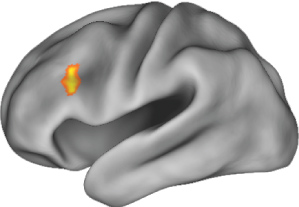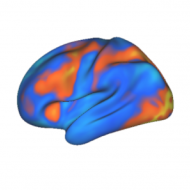 A new study – titled “Global Connectivity of Prefrontal Cortex Predicts Cognitive Control and Intelligence” – was published just last week. In it, my co-authors and I describe our research showing that connectivity with a particular part of the prefrontal cortex can predict how intelligent someone is.
A new study – titled “Global Connectivity of Prefrontal Cortex Predicts Cognitive Control and Intelligence” – was published just last week. In it, my co-authors and I describe our research showing that connectivity with a particular part of the prefrontal cortex can predict how intelligent someone is.
We measured intelligence using “fluid intelligence” tests, which measure your ability to solve novel visual puzzles. It turns out that scores on these tests correlate with important life outcomes like academic and job success. So, finding a neuroscientific factor underlying fluid intelligence might have some fairly important implications.
It turns out that it’s relatively unclear exactly what fluid intelligence tests actually test (what helps you solve novel puzzles, exactly?), so we also measured a more basic “cognitive control” ability thought to be related to fluid intelligence – working memory. This measures your ability to maintain and manipulate information in mind in a goal-directed manner.
Overall (i.e., global) brain connectivity with a part of left lateral prefrontal cortex (see figure above) could predict both fluid intelligence and cognitive control abilities.
What does this mean? One possibility is that this prefrontal region is a “flexible hub” that uses its extensive brain-wide connectivity to monitor and influence other brain regions in a goal-directed manner. This may sound a bit like it’s some kind of “homunculus” (little man) that single-handedly implements all brain functions, but in fact we’re suggesting it’s more like a feedback control system that is used often in engineering, that it only helps implement cognitive control (which supports fluid intelligence), and that it doesn’t do this alone.
Indeed, we found other independent factors that were important for predicting intelligence, suggesting there are several fundamental neural factors underlying intelligence. The global connectivity of this prefrontal region could account for 10% of the variability in fluid intelligence, while activity in this region accounts (independently) for 5% of the variability, and overall gray matter volume accounts (again independently) for an additional 6.7% of the variance. Together, these three factors accounted for 26% of the variance in fluid intelligence across individuals.
There are several important questions that this study raises. For instance, does this region change its connectivity depending on the task being performed, as the “flexible hub” hypothesis would suggest? Are there other regions whose global (or local) connectivity contributes substantially to intelligence and cognitive control abilities? Finally, what other factors are there in the brain that might be able to predict fluid intelligence across individuals?
-MC
